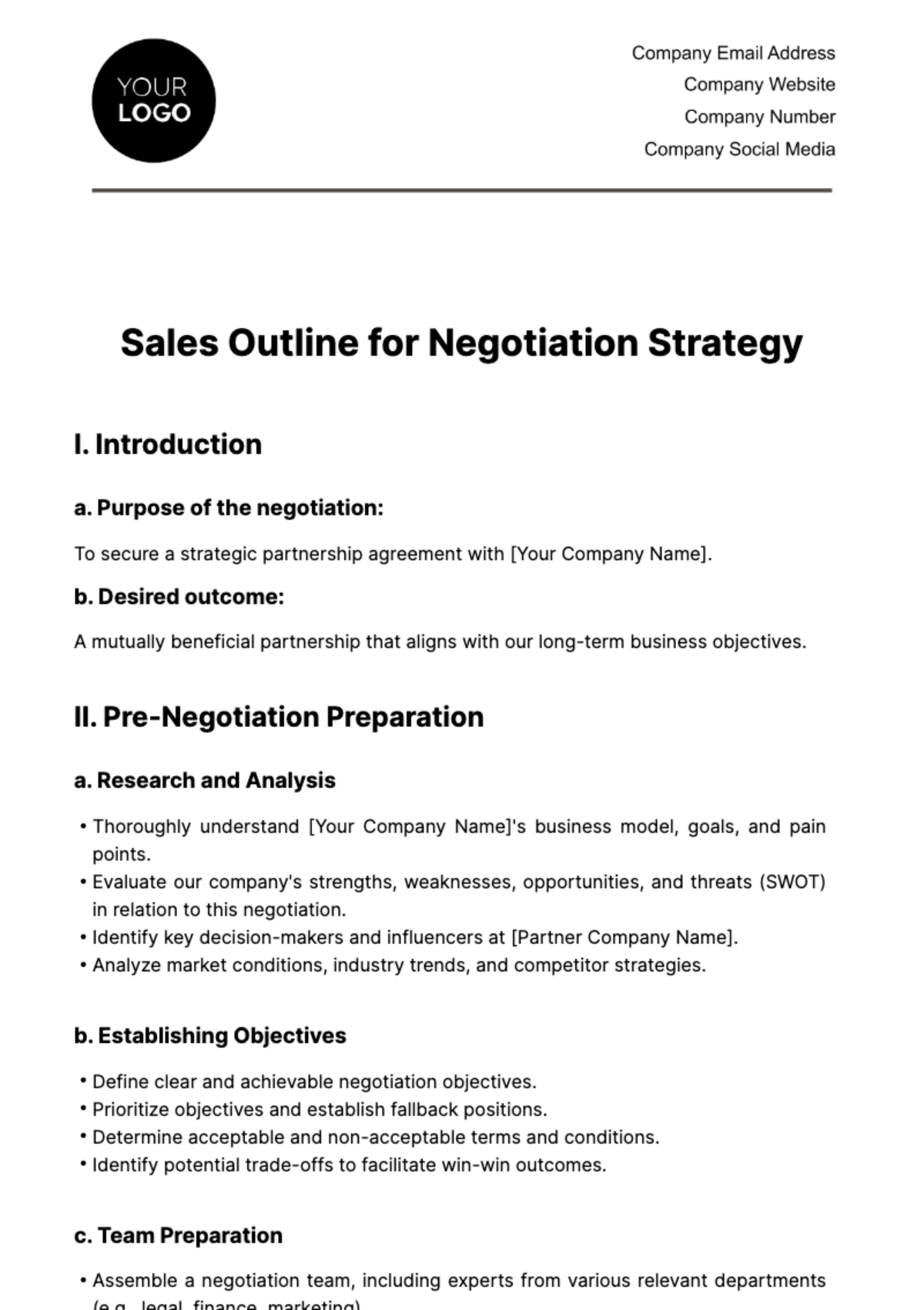Sales Outline for Negotiation Strategy
I. Introduction
a. Purpose of the negotiation:
To secure a strategic partnership agreement with [Your Company Name].
b. Desired outcome:
A mutually beneficial partnership that aligns with our long-term business objectives.
II. Pre-Negotiation Preparation
a. Research and Analysis
Thoroughly understand [Your Company Name]'s business model, goals, and pain points.
Evaluate our company's strengths, weaknesses, opportunities, and threats (SWOT) in relation to this negotiation.
Identify key decision-makers and influencers at [Partner Company Name].
Analyze market conditions, industry trends, and competitor strategies.
b. Establishing Objectives
Define clear and achievable negotiation objectives.
Prioritize objectives and establish fallback positions.
Determine acceptable and non-acceptable terms and conditions.
Identify potential trade-offs to facilitate win-win outcomes.
c. Team Preparation
Assemble a negotiation team, including experts from various relevant departments (e.g., legal, finance, marketing).
Assign roles and responsibilities within the team.
Conduct a pre-negotiation briefing to align team members on objectives, strategies, and key talking points.
III. Negotiation Tactics
a. Building Rapport
Begin with a friendly and respectful tone.
Establish common ground and shared objectives.
Actively listen to [Your Company Name]'s concerns and priorities.
b. Information Sharing
Present our company's strengths, achievements, and the unique value we bring to the table.
Address potential areas of concern transparently, providing solutions or mitigation strategies.
Gather information about [Your Company Name]'s needs, challenges, and expectations.
c. Framing the Negotiation
Define the negotiation scope, agenda, and key issues.
Propose an initial offer that aligns with our objectives but allows room for concessions.
Set a collaborative tone, emphasizing the mutual benefits of the partnership.
d. Concession Management
Develop a clear strategy for making concessions while maintaining our core objectives.
Seek reciprocal concessions from [Your Company Name].
Avoid making unilateral concessions without receiving value in return.
IV. Agreement and Closure
a. Creating Value
Identify areas where we can create additional value for both parties.
Explore potential add-ons, incentives, or innovative solutions.
Emphasize the long-term benefits of the partnership.
b. Legal and Compliance
Engage legal counsel to review and finalize the agreement.
Ensure compliance with all relevant laws and regulations.
Address any intellectual property, confidentiality, or liability concerns.
c. Agreement Signing
Schedule a signing ceremony to celebrate the partnership.
Coordinate with [Partner Company Name] to ensure a smooth transition.
Establish clear communication channels for post-negotiation cooperation.
V. Post-Negotiation Evaluation
a. Debriefing
Conduct a post-negotiation debrief with the internal team to assess the negotiation process and outcomes.
Identify lessons learned and areas for improvement.
Document key takeaways for future negotiations.
b. Continuous Relationship Building
Conclusion
This negotiation strategy outlines the approach we will take to secure a successful partnership agreement with [Your Company Name]. It emphasizes a cooperative and value-driven approach while ensuring the protection of our company's interests. Continuous evaluation and relationship-building will be key to the long-term success of this partnership.
Prepared by: [Your Name]
Position: [Your Title]
Date: [Month, Day, Year]
Sales Templates @ Template.net




























